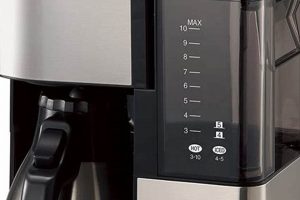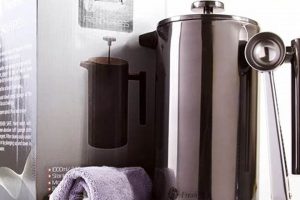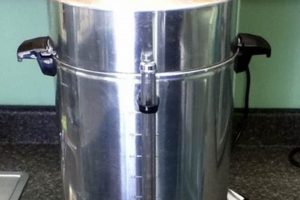This brewing device is a visually striking and technically intricate method for producing coffee. Utilizing two chambers and principles of vapor pressure and vacuum, it creates a distinctive and aromatic coffee experience. Water is heated in a lower chamber, and the resulting pressure forces it into an upper chamber containing coffee grounds. Once heating ceases, a vacuum draws the brewed coffee back down into the lower chamber, leaving the grounds behind.
The elegance and spectacle of this brewing method contribute to its appeal. Beyond aesthetics, it is believed by some to yield a clean and flavorful cup, owing to the controlled brewing environment and the cloth filter often employed. Historically, these brewers have been associated with a certain level of prestige and have been admired for their craftsmanship and precision.
The subsequent sections will delve into the specific components, operation, and maintenance of this fascinating coffee preparation system, as well as provide guidance on achieving optimal results and addressing potential issues.
Tips for Optimal Operation
Achieving consistently excellent results with this equipment requires careful attention to several key factors. The following tips are designed to enhance the brewing process and safeguard the longevity of the device.
Tip 1: Water Quality is Paramount: Employ filtered water to minimize mineral buildup within the chambers. Mineral deposits can impede heat transfer and alter the final beverage’s taste profile. Regularly descale the lower chamber as needed based on usage frequency and water hardness.
Tip 2: Grind Size Matters: A medium-fine grind, similar to that used for drip coffee, is generally recommended. Finer grinds can lead to clogging, while coarser grinds may result in under-extraction and a weak brew.
Tip 3: Precise Heat Control is Crucial: The heat source should be carefully monitored to prevent overheating or a rapid boil. Gradual heating ensures even pressure and reduces the risk of damage to the glass components. Many modern units include adjustable heat settings for improved control.
Tip 4: Pre-Heat the Upper Chamber: Warming the upper chamber slightly before introducing the heated water can help stabilize the brewing temperature and promote consistent extraction.
Tip 5: Stir Gently and Evenly: Once the water has transferred to the upper chamber, gently stir the coffee grounds to ensure thorough saturation. Avoid over-stirring, which can agitate the grounds excessively and lead to bitterness.
Tip 6: Monitor the Brew Time: A brewing time of approximately 60-90 seconds after the water has fully transferred is generally sufficient. Adjust the brewing time based on personal preference and the desired strength of the coffee.
Tip 7: Proper Cleaning is Essential: Thoroughly clean all components after each use. Remove spent coffee grounds and rinse the chambers with warm water. Pay particular attention to the filter, ensuring it is free of debris.
Tip 8: Inspect Seals and Connections: Regularly check all seals and connections for wear or damage. Replacement of worn parts is essential to maintain proper pressure and vacuum, ensuring the equipment functions optimally and safely.
Adhering to these guidelines will contribute to a superior brewing experience, resulting in a consistently flavorful and enjoyable coffee.
The subsequent section will provide detailed instructions on cleaning and maintaining this unique brewing apparatus, further ensuring its longevity and optimal performance.
1. Visual Spectacle
The operational mechanics of the Belgian siphon coffee maker inherently present a captivating visual display. The transfer of water from the lower chamber to the upper chamber, driven by vapor pressure, is observable through the glass components, creating a dramatic and engaging process. The subsequent descent of the brewed coffee back into the lower chamber, facilitated by a vacuum, further enhances this spectacle. This visual element is not merely aesthetic; it actively contributes to the perceived value and overall experience of using the device.
Consider, for example, establishments that feature this brewing method as a centerpiece. The deliberate showcasing of the brewer and its operation often serves as a point of conversation and a demonstration of craftsmanship. The rhythmic bubbling, the movement of liquids, and the elegant design all contribute to a sensory experience that transcends the simple act of coffee preparation. In these settings, the visual spectacle is a key component of the product offering, influencing customer perception and potentially justifying a premium price point.
In conclusion, the “Visual Spectacle” of the Belgian siphon coffee maker is inextricably linked to its appeal and perceived value. This element enhances the experience and separates it from more commonplace brewing methods. Its significance lies in its contribution to the overall sensory experience, which can elevate the act of coffee preparation into a form of performance and artistry.
2. Vapor Pressure
The operational principle of the siphon coffee maker is fundamentally reliant on vapor pressure. The application of heat to the water in the lower chamber causes a phase transition from liquid to gas, increasing the pressure within the sealed environment. This elevated pressure is the driving force that propels the heated water through a connecting tube and into the upper chamber, where the coffee grounds are situated. Without this precisely generated vapor pressure, the transfer of water necessary for the brewing process would not occur.
The degree of heat applied directly influences the magnitude of the vapor pressure. Inadequate heat results in insufficient pressure, leaving water remaining in the lower chamber, and under-extraction occurs. Conversely, excessive heat leads to a rapid and uncontrolled increase in pressure, potentially causing damage to the glass components or disrupting the brewing process. Manufacturers design these units with consideration for optimal vapor pressure at specific temperature ranges to ensure both functionality and safety. The control of the heat source is therefore essential for consistent and reliable operation.
In conclusion, vapor pressure is an indispensable component in the functionality of siphon coffee makers. Its generation and management determine the successful transfer of water for brewing. Understanding the relationship between heat input and vapor pressure allows for optimized control over the brewing process, leading to consistent results and minimizing the risk of equipment malfunction.
3. Vacuum Filtration
The concluding phase of the brewing process in a siphon coffee maker is intrinsically linked to vacuum filtration. Once the heat source is removed from the lower chamber, the air within cools, leading to a reduction in pressure. This pressure decrease creates a vacuum, drawing the brewed coffee from the upper chamber, through a filter, and back into the lower chamber. This vacuum-assisted filtration process is critical for separating the coffee grounds from the finished beverage, resulting in a sediment-free and clear cup of coffee.
The type of filter employed significantly influences the final coffee characteristics. Cloth filters, commonly used in these brewers, offer a high degree of filtration, capturing even fine particles. This contributes to a smooth and delicate flavor profile, often favored by enthusiasts. Metal filters, while offering greater durability and reusability, may allow some sediment to pass through, potentially affecting the coffee’s texture and mouthfeel. The effectiveness of the vacuum in drawing the coffee through the filter directly impacts the speed and completeness of the filtration process. A strong vacuum ensures efficient separation, while a weak vacuum may prolong the process and leave residual coffee in the upper chamber.
In summary, vacuum filtration is an integral function of siphon coffee makers, enabling the separation of coffee grounds and the production of a clear, sediment-free beverage. The efficiency of this process is directly tied to the strength of the vacuum and the type of filter utilized. Understanding the dynamics of vacuum filtration is essential for optimizing the brewing process and achieving consistent results.
4. Heat Source
The heat source is a critical component dictating the functionality and brewing characteristics of a Belgian siphon coffee maker. It initiates the brewing process by creating the vapor pressure necessary to transfer water to the upper chamber. Variations in heat source type and intensity directly impact the water temperature, pressure generation rate, and subsequently, the coffee extraction process. An inadequate heat source fails to generate sufficient pressure, leading to incomplete water transfer and under-extraction, while excessive heat can result in uncontrolled boiling and potentially damage the equipment. Examples include butane burners, halogen lamps, and electric heating elements. Butane burners offer portability but require careful monitoring to maintain consistent heat. Halogen lamps provide more precise temperature control, but their intensity may require adjustment based on ambient conditions. Electric heating elements offer automated temperature regulation, improving consistency.
The practical significance of understanding the heat source lies in optimizing the brewing process. Consistent water temperature ensures repeatable extraction rates, leading to predictable flavor profiles. Heat source management involves adjusting the intensity and duration of heating based on the desired coffee strength and roast level. For instance, a darker roast may require lower temperatures and shorter brewing times to prevent over-extraction and bitterness. Furthermore, understanding the specific heat output characteristics of the chosen source allows for calibration and fine-tuning of the brewing process, thereby maximizing the potential of the coffee grounds.
In summary, the heat source forms an integral link in the operation of a Belgian siphon coffee maker. The proper management of the heat source influences water temperature, pressure, and extraction rates, directly affecting the resulting coffee’s flavor profile. A knowledgeable approach to heat source selection and management promotes consistency, reduces the risk of equipment damage, and enhances the overall brewing experience. Challenges include accommodating variability in heat source output and maintaining consistent operation across different environments. Further research could explore the integration of feedback control systems to optimize heat source regulation and enhance brewing precision.
5. Glass Components
The integration of glass components is fundamental to the design and operation of the siphon coffee maker. These elements serve not only as functional vessels for brewing but also contribute significantly to the aesthetic appeal and operational transparency inherent in this method. The upper and lower chambers, typically constructed from borosilicate glass due to its thermal shock resistance, provide the necessary containment for water, coffee grounds, and the brewed beverage. The clear nature of the glass enables visual monitoring of the brewing process, allowing observation of water transfer, coffee grounds saturation, and the final filtration stage. This transparency provides a level of engagement absent in other brewing methods, fostering a sense of control and understanding over the brewing variables. Damage to these glass components invariably renders the device inoperable, underscoring their critical role.
The practical significance of using glass extends beyond visual appeal. The relative inertness of glass minimizes the potential for chemical reactions that might alter the flavor profile of the coffee. Unlike some metals or plastics, glass does not impart any taste or odor, allowing the inherent characteristics of the coffee beans to be expressed without interference. Furthermore, the smooth surface of glass facilitates cleaning and reduces the likelihood of residue buildup, which can compromise the taste of subsequent brews. In manufacturing, precise shaping and sealing of the glass components are essential for maintaining airtight conditions, which are critical for generating the pressure and vacuum necessary for the brewing process. Imperfections in the glass can lead to pressure leaks, diminished brewing efficiency, and potentially hazardous operational conditions. Historical examples demonstrate that early iterations of siphon coffee makers using less durable glass were prone to breakage, hindering their widespread adoption.
In summary, the glass components are indispensable to the functionality, safety, and aesthetic appeal of the siphon coffee maker. Their properties enable visual monitoring, prevent flavor contamination, and contribute to the creation of the necessary pressure and vacuum for brewing. The choice of borosilicate glass reflects a balance between thermal resilience and chemical inertness, ensuring both operational integrity and the preservation of coffee flavor. Challenges related to glass brittleness and manufacturing precision remain relevant in the design and production of these devices, driving ongoing innovation in materials science and engineering.
6. Brewing Ritual
The use of a Belgian siphon coffee maker extends beyond mere coffee preparation; it encompasses a deliberate brewing ritual, elevating the process to an art form. This ritual involves a series of precise steps and considerations that contribute to the final beverage and the overall experience. The following facets explore the elements contributing to this intricate brewing ritual.
- Preparation of Components
The ritual begins with the meticulous preparation of all components. This includes ensuring the glass chambers are clean and free of residue, verifying the integrity of the filter, and measuring the appropriate amount of coffee grounds and water. This pre-brewing stage sets the foundation for a successful and consistent brewing process.
- Controlled Heating and Pressure
The heating phase is a crucial aspect of the ritual. Observing the water temperature rise and the subsequent vapor pressure build-up is integral to the brewing experience. The operator must carefully monitor the heat source to prevent over-boiling or insufficient pressure, adjusting as necessary to maintain optimal conditions. This requires attentive observation and a degree of expertise to ensure the water effectively transfers to the upper chamber.
- Observation and Timing
The actual brewing phase involves careful observation and timing. Once the water has fully transferred, the operator gently stirs the coffee grounds to ensure complete saturation. The brew time is then carefully monitored, typically ranging from 60 to 90 seconds, depending on the desired strength and roast level. This precise timing is essential for optimal extraction and prevents over or under-extraction.
- Vacuum Filtration and Completion
The culmination of the brewing ritual occurs as the heat source is removed. The resulting vacuum draws the brewed coffee back through the filter into the lower chamber. The operator observes the filtration process, noting the clarity and color of the final beverage. Once the filtration is complete, the coffee is carefully poured and served, marking the end of the ritual.
These facets of the brewing ritual, when combined, transform coffee preparation into a deliberate and engaging experience. The Belgian siphon coffee maker is not simply a means to an end; it is an instrument that demands attention, precision, and a degree of artistry. This heightened level of involvement cultivates a deeper appreciation for the coffee itself and enhances the overall sensory experience. The performance aspect is also part of this ritual because of its sophisticated appearance, the Belgian Siphon Coffee Maker makes for a very performative brewing method to do.
Frequently Asked Questions
This section addresses common inquiries and concerns related to the operation and maintenance of this brewing system.
Question 1: Is this system inherently dangerous due to its use of glass and pressure?
When operated according to manufacturer instructions and with proper care, the system is not inherently dangerous. Modern devices incorporate safety features such as pressure relief valves and durable borosilicate glass components. Regular inspection and maintenance are crucial to ensure safe operation.
Question 2: How frequently should the filter be replaced?
Filter replacement frequency depends on usage and filter type. Cloth filters require more frequent replacement, typically every few weeks or after noticeable discoloration. Metal filters, while more durable, also require periodic replacement if damaged or clogged. Consult the manufacturer’s recommendations for specific guidelines.
Question 3: What is the optimal water temperature for this type of brewing?
The optimal water temperature varies depending on the specific model and the desired flavor profile. Generally, a temperature range of 195-205F (90-96C) is recommended. Precise temperature control, often available on electric models, is essential for consistent results. Employing a thermometer to verify water temperature is advised.
Question 4: Can this system be used with pre-ground coffee?
While pre-ground coffee can be used, freshly ground beans are highly recommended to maximize flavor. Pre-ground coffee tends to lose its volatile aromatic compounds more rapidly, resulting in a less flavorful brew. Grind size should also be appropriate for siphon brewing, typically medium-fine.
Question 5: What causes the coffee to taste bitter when brewed with this system?
Bitterness can result from several factors, including over-extraction, excessive water temperature, or the use of stale coffee beans. Reducing brew time, lowering the water temperature, or using a coarser grind can mitigate bitterness. Additionally, ensuring that all components are thoroughly cleaned between uses is essential.
Question 6: Is this brewing method significantly better than other methods, such as pour-over or drip?
The perceived superiority of this brewing method is subjective. It is believed by some to produce a cleaner cup with more clarity due to the filtration process. The unique brewing process and visual spectacle also contribute to its appeal. However, other methods can also produce excellent coffee when executed properly.
Proper operation and maintenance are paramount for achieving consistent and high-quality results with this brewing system. Adherence to the manufacturer’s instructions and attention to detail are essential.
The following section will explore troubleshooting tips and solutions for common issues encountered with this equipment.
Conclusion
This exploration has detailed the operational principles, key components, and maintenance considerations associated with the belgian siphon coffee maker. The distinctive brewing process, reliant on vapor pressure and vacuum filtration, yields a visually captivating and potentially nuanced coffee experience. Optimal operation necessitates a thorough understanding of temperature control, grind size, and component maintenance.
The continued appreciation of the belgian siphon coffee maker stems from its unique blend of scientific principles and aesthetic appeal. Further research and development may refine brewing consistency and enhance user-friendliness. The commitment to informed usage and meticulous care will ensure the longevity and optimal performance of this intricate brewing apparatus. In future models, there is an opportunity for better thermal-regulation and improved glass structural integrity. The belgian siphon coffee maker, with it’s long history, may continue to develop well into the future with improved design and manufacturing, improving both the product itself and the experience of the ritual of its use.







![The Best Turquoise Coffee Maker: [Brand Name] & More! Safem Fabrication - Precision Engineering & Custom Manufacturing Solutions The Best Turquoise Coffee Maker: [Brand Name] & More! | Safem Fabrication - Precision Engineering & Custom Manufacturing Solutions](https://deacoffee.com/wp-content/uploads/2025/06/th-1651-300x200.jpg)